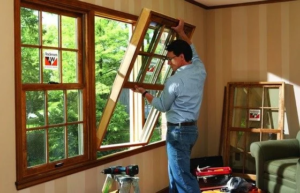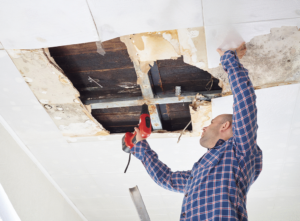If you’re looking to replace your windows, it’s important to do some research. It will help you narrow down your options and find the best fit for your home.
Replacement Windows Lexington KY offer more than natural light and a refreshed look. They also come with many benefits that will last a lifetime.

Improved Energy Efficiency
Energy-efficient replacement windows can provide a number of ways to save money and improve your home’s comfort. They reduce unwanted heat loss and condensation, helping your heating and cooling systems work more efficiently. They also help prevent harmful UV rays from entering your home, which can cause fabric and wood furniture to fade over time.
New replacement windows can also reduce noise, creating a quieter indoor living environment for you and your family. They are especially useful if you live near a busy road or other noisy areas, as they help to reduce traffic and construction noises.
While you may be paying more upfront for your replacement windows, they can often help you recoup the cost in savings on your utility bills and increased home value when it comes time to sell your house. According to Remodeling Magazine, vinyl window-replacement projects have one of the highest returns on investment among all remodeling projects, with homeowners able to recoup around 80 percent of their installation costs.
Choosing the right replacement window is essential to ensure that your project provides the best possible return on investment. Experienced installers will use quality materials and tight seals to prevent air leaks, improving insulation and overall performance. They can also add energy-efficient features such as low-E coatings and argon gas-filled panes, allowing you to reap the benefits of reduced energy consumption while still enjoying your view and comfortable indoor temperatures.
Replacement windows come in a variety of styles and materials, ensuring that you can find the perfect fit for your property’s architectural style and interior design. They are also available in a wide range of finishes and colors, allowing you to customize your replacement window for a truly unique look.
Better Aesthetics
Your home’s aesthetics are a clear representation of your personality and style preferences. From paint colors to furniture, wall art, and more, every element works together to elevate your living spaces and create a lasting impression on anyone who enters your home. The same is true for your windows — replacing old, outdated windows with modern ones can drastically improve your home’s appearance.
Whether you opt for casement, sliders, bay, bow, awning, or picture (fixed pane) windows, today’s replacement options come in a wide range of designs to fit your personal style preferences. From grilles to muntins, the countless options available allow you to customize your window’s design to perfectly complement your home’s architectural details and interior decor.
In addition to their aesthetic appeal, many of today’s replacement windows come with features that make them more energy efficient. From low-E coatings to inert gas fills between glass panes, these features minimize heat transfer and can significantly reduce your energy bills.
As a result of their energy efficiency and superior aesthetics, new replacement windows are a top renovation choice among homeowners looking to boost their home’s curb appeal. The right window replacements can dramatically change your home’s exterior, instantly elevating it to the next level of beauty and value.
Quieter Home
When you replace old windows, you create a sound barrier against unwanted outdoor noise. Modern double- and triple-paned windows reduce outside noise, making your home more peaceful and relaxing. This is especially helpful if you live near a busy road or under a flight path.
Window replacements are also easy to open, close and clean. This helps you keep them looking great and protects the interior of your home from moisture. If you have older windows, moisture can damage the frame and cause rot and mold. New replacement windows prevent this by preventing air leaks and heat transfer, creating a more stable indoor temperature.
In addition to reducing energy use, new windows can help you save money by lowering your heating and cooling bills. The superior insulation of new replacement windows helps keep your home at a more comfortable temperature, reducing the load on your HVAC system. This means you can save on energy costs and potentially extend the life of your equipment.
Replacement windows allow you to upgrade your home without disrupting the existing walls, trim and siding. This makes them a cost-effective option for homeowners who want to improve the look of their property without major renovations.
Increased Home Value
When it comes to increasing your home’s value, few projects are as effective as replacement windows. Depending on the style you choose, energy efficiency and curb appeal, this project can provide a great return on investment at resale.
In addition, premium replacement windows can increase your home’s value with the added benefit of lower utility bills. The government-backed Energy Star label indicates that homes with these windows can save an average of 12% a year on their energy bills. That savings can add up quickly.
New windows can be a smart choice for any homeowner, but they are especially attractive to those who might want to sell their home in the future. Buyers will recognize the enhanced beauty and energy efficiency of new windows, and are often willing to pay a premium for these features.
If your window frames are rotting, warping or in disrepair, it’s time to consider replacement options. Leaking and drafty windows can eat away at your home’s energy efficiency and comfort, as well as your wallet.
Unlike a new construction window, which is typically used in newly built homes or additions, replacement windows do not require major alterations to the existing walls and trim. This means that they can be installed in homes of any age, from historic to contemporary. They are also a good choice for homeowners who prefer not to disrupt the architectural integrity of a home’s exterior. In fact, bay and bow windows are a popular option for people looking to enhance their home’s exterior beauty without changing its architectural look. These windows feature three or more windows angled together to create an extra space and an inviting reading or seating area.
Increased Home Comfort
Unlike older windows that leak and allow air from outside to slip into your home, new replacement windows will keep your indoor air trapped inside for maximum comfort. This also reduces your reliance on the heating or cooling system, saving you money.
With the winter chill setting in, new windows will keep your home warm and cozy. This is due to their advanced design that prevents cold air from seeping into your space, keeping you toasty throughout the entire season.
In addition, new windows offer superior insulation that creates a stable indoor temperature year-round without drafts or hot or cold spots. They also prevent air leaks, reducing your energy usage and carbon footprint.
The summer sun is lovely, but it can cause excessive heat in your space and damage furniture and other materials. Thankfully, replacement windows with built-in tints can neutralize these harmful UV rays, keeping your space comfortable and preserving your furniture.
Another way to increase your overall home comfort is by installing noise-reducing replacement windows. These windows will minimize exterior noise, such as street sounds, neighborhood dogs, heavy equipment, trains, or planes, creating a peaceful and relaxing atmosphere for you and your family to unwind in.
New windows will also help prevent the growth of mold and other allergens, making your home a healthier place to live. Old windows prone to air leaks and condensation can create an ideal environment for these allergens, which can trigger health issues. This is because the moisture can make its way into your walls and furniture, which can then trigger asthma and other respiratory problems. However, the proper insulation and preventing air leaks that are common with older windows will prevent these issues.
